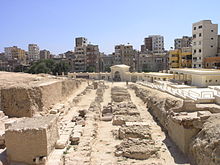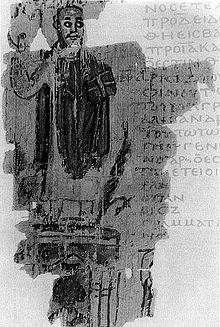Library of Alexandria
![]()
This article is about the ancient library. For the modern library of Alexandria, see Bibliotheca Alexandrina.
The Library of Alexandria was the most important ancient library. It was founded at the beginning of the 3rd century BC in the Macedonian-Greek city of Alexandria, which had been founded shortly before in Egypt. The date of the end of the library is unclear. Assumptions range from 48 BC to the 7th century. The view is often expressed that it fell victim to the destruction of the entire palace district of Alexandria in the 3rd century. So far, no remains of the library have been found, but the texts of ancient authors offer some information.
The library had an enormous stock of scrolls by the standards of the time, but unknown today. These were both literary writings and large quantities of scientific literature from a wide range of disciplines. It can be assumed that a large stock was already available soon after its foundation, and that it continued to grow over the generations. A smaller subsidiary library in the Serapeion of Alexandria was located in the southwest of the city in a district inhabited by native Egyptians.
The library's premises were located in the palace district of the city and were closely related to an important scientific institution, the Museion of Alexandria, where numerous famous scholars worked and the Alexandrian School emerged. Probably the essential function of the library was that of a school and research library of the Museion. These two institutions, financed by the Ptolemaic rulers, played a considerable part in Alexandria replacing Athens as the center of Greek scholarship in the 3rd century BC. The library, however, served not only scientific purposes, but also the demonstration of power of the Ptolemies. It was founded as part of the large-scale cultural policy of the Macedonian-Greek king Ptolemy I in the residence and capital of his Egyptian empire. The library continued to operate under Roman administration (from 30 BC).
Apart from historical and archaeological research, numerous myths surround the library's after-effects, which continue to this day. It is considered a legendary archetype of a universal library and an ideal-typical storehouse of knowledge. Speculation about the destruction of the library is particularly widespread. However, the fact that it fell victim to a spectacular fire in 48 BC is just as unlikely as the legend of its destruction by the Arabs in 642.
The daughter library in the Serapeion
See also: Serapeion of Alexandria
A smaller library, later also called "daughter", was probably founded by Ptolemy III. It was housed - in the tradition of Egyptian temple libraries - in the temple of Serapis, which was located on a hill above the city. The temple and library were located in the Egyptian quarter of Rakotis. Therefore, the daughter library is assigned in research to the tradition of Egyptian temple libraries. It probably served the cultural integration of the natives living there. According to an ancient report, it was equipped with 42,800 scrolls. Some of these may have been duplicates of the mother library. It is likely that at least at some times the library in the Serapeion was open to the educated public. The Serapeion has been excavated since the 1940s; identification of the library rooms has been attempted but is not certain.
The temple and library were completely destroyed in 391. This happened in the context of the violent conflicts in which the Christian emperorship, in this case Emperor Theodosius I, and the state and ecclesiastical authorities of Alexandria confronted the pagan part of the population. In 391, the then Patriarch of Alexandria, Theophilos, ordered the destruction of the Serapeion, which had become a center of pagan cults and scholarship. The preceding conflict and probably the destruction itself were accompanied by bloody rioting and looting. Theophilos had a Christian church built on the site of the temple.

Remains of the Serapeion

Theophilos standing triumphantly on the Serapeion (late antique book illustration)
Questions and Answers
Q: What was the Library of Alexandria?
A: The Library of Alexandria was a significant library of the ancient world that was located in Alexandria, Egypt. It was a major center of scholarship that flourished under the patronage of the Ptolemaic dynasty.
Q: When was the Library of Alexandria built?
A: The Library of Alexandria was built in the third century BC.
Q: What is the Greek term used by many historians of the era to refer to the Library of Alexandria?
A: The Greek term bibliotheke (βιβλιοθήκη) is used by many historians to refer to the collection of books, not to any building.
Q: What was the library known as in ancient Latin?
A: In ancient Latin, the library was known as the "ALEXANDRINA BYBLIOTHECE".
Q: Who was the Library of Alexandria patronized by?
A: The Library of Alexandria was patronized by the Ptolemaic dynasty.
Q: When was the Library of Alexandria opened?
A: The Library of Alexandria was conceived and opened either during the reign of Ptolemy I Soter or during the reign of his son Ptolemy II.
Q: What complicates the history and chronology of the Library of Alexandria?
A: The fact that the Greek term bibliotheke refers to the collection of books, not to any building, complicates the history and chronology of the Library of Alexandria.
Search within the encyclopedia